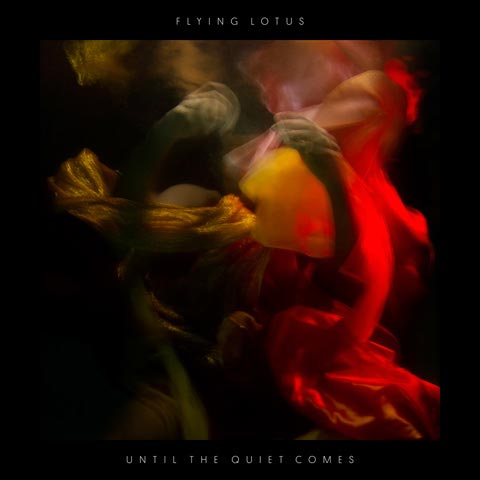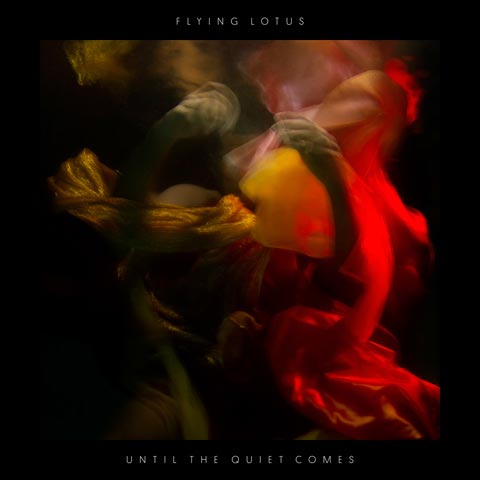
There is a moment on the new Flying Lotus record — let’s call it the first five seconds — when one has to decide whether to climb aboard Steve Ellison‘s shimmering magic carpet for the next half hour (or century… drugs like this tend to distort time a little) or to simply survey the beautiful landscape he’s laid out on his newest album-trip, Until the Quiet Comes.
I say this because like all Flying Lotus records, there are a myriad of experiences to be had within the layers of subtle details, ranging from active to passive and or up and down to goddamn spiritually ecstatic.
Flying Lotus – Until The Quiet Comes Album Review (cont’d)
There’s bouncy elven hip-hop, fashioned from skewered samples of jazzy breaks and the occasional A-list vocalist (Erykah Badu and Thom Yorke in this case), which works for casual listening and car speakers. And then there are the swimming oscillations of otherworldly sounds waiting, just behind those headphones, to constitute Ellison’s captivating psychedelic vision that is hilariously here, terrifying there, and beautiful all around.
Given that Flying Lotus’ tracks rarely break the two-minute mark, it doesn’t take long to realize that Until the Quiet Comes is the slow-burning baby-making stargazing jam to Cosmogramma‘s ass-disorienting free jazzing. This is the sound of geodesic space complete with melting patterns, good laughs, startling revelations, and all. He’s even kind enough to include a track called “DMT Song” just to make sure we’re all on the same page. That track by the way, is a beautiful snapshot of Ellison’s project past, present, and future, beginning with a gorgeously stupid trip report by Thundercat and ending with one of the more spaced out boogies on the album — one which captures both the giddy joy and monastic awe that makes his music so dynamic and powerful. (Editor’s note: see “DMT Song” feature below.)
Until the Quiet Comes is more concerned with suggesting space than filling it, so it might come as a disappointment to those who refuse to give themselves over entirely to the ride. Those looking for short but heavy, heady finger-drumming grooves might want to look into Ellison’s back catalog. But for those initiates willing to explore the inner reaches of the Flying Lotus universe, it serves as stark reminder that John and Alice were only the beginning of the Coltrane legacy of achieving individuation through sound.
Track Analysis: Insight Into “DMT Song” & The Great Psychedelic Beyond

DMT is a naturally-occurring psychedelic compound from the tryptamine family. DMT occurs in notable amounts throughout the plant kingdom and in trace amounts in mammals, including humans. However, it is only active as a psychoactive when ingested.
As summarized by Wikipedia, “Depending on the dose and method of administration, its subjective effects can range from short-lived milder psychedelic states to powerful immersive experiences; these are often described as a total loss of connection to conventional reality with the encounter of ineffable spiritual/alien realms.”
DMT is also a prime component of the plant-based hallucinogenic compound known as ayahuasca.
Flying Lotus’ last album, Cosmogramma, was termed after Ellison’s aunt, the late musician-turned-spiritual leader and wife of John Coltrane, A.C. Turiyasangitananda (formerly known as Alice Coltrane). “Cosmogramma” was used by Coltrane in a lecture, to explain how the material world as human beings know it is completely illusory. Themes on Until The Quiet Comes continue these themes, and “DMT Song” is perhaps the most astoundingly blatant indicator.
DMT, or Dimethyltryptamine, is a powerful psychoactive drug. Ellison has long been a cautious proponent of its use, though he revealed to Interview in 2012 that he has only done it twice. Nonetheless, those rare occurrences were enough to warrant a track dedicated to the topic.
In early 2009, Ellison shared a blog entry on Myspace about his first DMT experience. In it, he weighed its positives and negatives, his fears going into it and his insights coming out of it, only to ultimately summarize the experience by saying: “My brain was fed! It was by far the most incredible experience I’ve ever had… Even though I’ve had a bit of a ‘breakthrough’, I’m sure I’ve barely scratched the surface…”
(Humorously, Thom Yorke’s voice on Radiohead’s “Pyramid Song” played a particularly profound role on that first trip, and the oscillating in-and-out of Yorke’s voice in Ellison’s then-mutated world recalls the feeling of Yorke’s disembodied vocals in Until The Quiet Comes‘ “Electric Candyman”.)
DMT users have been well-documented to experience similar visions, events, and revelations. American teacher, lecturer and writer Terence McKenna can be credited for popularizing many of those shared experiences. Though it is certainly open to interpretation and may even be incorrect, it is my supposition and that of the album reviewer that “DMT Song” plays off two associations common to DMT trips. These include an opening sound, similar to that of cellophane crinkling, and an elf-like, echoing chorus, which is brought to life in the track by layers upon layers of Thundercat’s voice.
“Rap Dancing Into The 3rd Millenium” (1994)
In the video at right, McKenna describes the crinkling sound that comes after one smokes enough DMT to cross from this reality to another one. “And when you [exceed that threshold],” he says, “this membrane-like thing, this chrysanthemum, will actually part, and there is this sound like the crumpling of a plastic bread wrapper, or the crackling of flame.”
Likewise, otherworldly beings, popularized by McKenna as “machine elves“, were described in his and his brother Dennis’ 1975 book, The Invisible Landscape, as “apparently autonomous and intelligent, chaotically mercurial and mischievous machine elves encountered in the trance state, strange teachers whose marvelous singing makes intricate toys out of the air and out of their own continually transforming body geometries.”
Though we can’t say for certain that Ellison is a follower of McKenna’s works, what is clear is Until The Quiet Comes‘ and Ellison’s respect for the psychoactive. It is important, though, that anyone being newly introduced to the substance through this music should research it thoroughly on their own and take the closing words from Ellison’s journal entry to heart.
“DMT isn’t a joke, its not a party drug, and it should be respected. As much as I feel that everyone should experience this, It really ISN’T for everyone and I ONLY recommend it for those who are seeking a spiritual experience. DMT will destroy your ego, and this reality as you know it. As amazing and profound and brief as it was, there are SOME people that should NEVER EVER have this experience. You know who you are, Please travel responsibly.”- – Steve Ellison of Flying Lotus, DMT n me, January 2009
The following resources are good places to begin your personal research into DMT.
– Erowid DMT Vault
– Essential Psychedelic Guide on DMT
– DMT on DanceSafe
– DMT: The Spirit Molecule (Film)
– DMT: The Spirit Molecule (Book)
Ω







